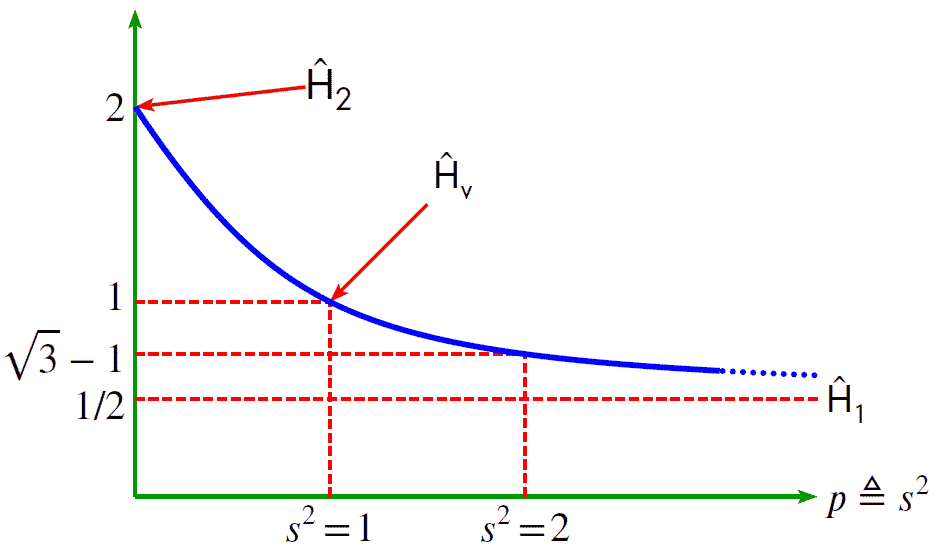Scaled Transfer Function Estimator
May 24, 2019
Back to: Mathematics for Understanding Waveform Relationships
The scaled transfer function estimator Ĥs(f) is an estimate of a system’s true transfer function with scaling factor s, where 0 ≤ s ≤ ∞.
The scaling factor s is the ratio of output noise power to input noise power such that Ŝ = Ŝyy / Ŝxx. This assumes that Ŝxx(f) and Ŝyy(f) are constant with respect to frequency f (x and y are white noise sequences.)
Ĥs is a generalization of the transfer function estimators Ĥ1, Ĥ2, and Ĥv.
Ĥs is defined as:
(1) ![Rendered by QuickLaTeX.com \begin{equation*} \frac{\~{S}_{yy}(\omega)-s^2\~{S}_{xx}(\omega) + \sqrt{[\~{S}_{yy}(\omega)-s^2\~{S}_{xx}(\omega)]^2 + 4s^2|\~{S}_{xy}(\omega)|^2}}{2\~{S}_{xy}(\omega)} \end{equation*}](https://vru.vibrationresearch.com/wp-content/ql-cache/quicklatex.com-e6a41dd3e8b201817b9bb5cd97053a53_l3.png)
Alternate Forms
Using the technique of “rationalizing the denominator” (or, in this case, “rationalizing the numerator”), we can arrive at alternate and useful forms for the scaled transfer function estimator. Particularly, if we multiply the numerator and denominator by the rationalizing factor…
(2) ![]()
…we can arrive at the following equation:
(3) ![Rendered by QuickLaTeX.com \begin{equation*} \hat{H}_{s}(\omega) = \frac{2S_{xy}(\omega)}{S_{xx}(\omega)-\frac{1}{s^2}S_{yy}(\omega)+\sqrt{[S_{xx}(\omega)-\frac{1}{s^2}S_{yy}(\omega)]^2+4\frac{1}{s^2}|S_{xy}(\omega)|^2}} \end{equation*}](https://vru.vibrationresearch.com/wp-content/ql-cache/quicklatex.com-4ca9943b80d0a39ed80e3026f9fd4bd3_l3.png)
Moreover, if we divide the numerator and denominator by s², we get:
(4) ![Rendered by QuickLaTeX.com \begin{equation*} \hat{H}_{s}(\omega) = \frac{2s^2S_{xy}(\omega)}{s^2S_{xx}(\omega)-S_{yy}(\omega)+\sqrt{[s^2S_{xx}(\omega)-S_{yy}(\omega)]^2+4s^2|S_{xy}(\omega)|^2}} \end{equation*}](https://vru.vibrationresearch.com/wp-content/ql-cache/quicklatex.com-92571afdcf4733f655e524e954d88396_l3.png)
Special Cases
Ĥ1, Ĥ2, and Ĥv are special cases of the scaled transfer function estimator. Using the definition of Ĥs, we see:
- Ĥs=0 = Ĥ2
- Ĥs=1 = Ĥy
Using the second alternate form, we see that Ĥs→∞ = Ĥ1.

Figure 1.5. Transfer function, H, vs. the scaling factor, s, squared.
MATLAB® Resources
|
|
pwelch(…) |
Estimate power spectral density. |
|
|
|
cpsd(…) |
Estimate cross power spectral density. |
Example of MATLAB Code
clear % clear all variables format long g; % set format of text output N = 16; % length of input data sequence Fs = 1; % sample rate (used for scaling) percent = 50; % percent overlap Nfft = N * (1-percent/100); x= [0 0 0 0 0 0 0 0 0 0 0 1 1 1 0 0]'; y= [0 0 0 1 1 1 1 1 0 0 0 0 0 0 0 0]'; %--------------------------------------------------------------------------- % smoothing window %---------------------------------------------------------------------------- window = hanning(Nfft); % Hanning window %---------------------------------------------------------------------------- % calculate estimates %---------------------------------------------------------------------------- [Syx,freq]=cpsd( x,y,window,Noverlap,Nfft,Fs); % estimate Syx [Sxx,freq]=pwelch(x, window,Noverlap,Nfft,Fs); % estimate Sxx [Syy,freq]=pwelch( y,window,Noverlap,Nfft,Fs); % estimate Syy> % | | | | | | | | |_________ sample rate % | | | | | | | |_____________ estimate length % | | | | | | |_____________________ num. overlapping positions % | | | | | |_____________________________ window type % | | | | |_________________________________ data sequence y % | | | |___________________________________ data sequence x % | | |_______________________________________ estimation operation % | |_____________________________________________ x-axis sequence % |___________________________________________________ estimate sequence %---------------------------------------------------------------------------- % estimate scaling parameters %---------------------------------------------------------------------------- s = var(y)/var(x) % this is 'not' a recommended way to estimate s! %---------------------------------------------------------------------------- % estimate Hs %---------------------------------------------------------------------------- Hs = estimate_Hs(s,Sxx,Syy,Sxy); %---------------------------------------------------------------------------- % function to estimate Hs %---------------------------------------------------------------------------- function Hs = estimate_Hs(s,Sxx,Syy,Sxy) u1 = Syy; u2 = s * Sxx; u3 = (s * Sxx - Syy) .* (s * Sxx - Syy); u4 = abs(Sxy) .* abs(Sxy); v1 = 2.0 * Sxy; Hs = (u1 - u2 + sqrt(u3 + 4 * s * u4)) ./ v1; end
